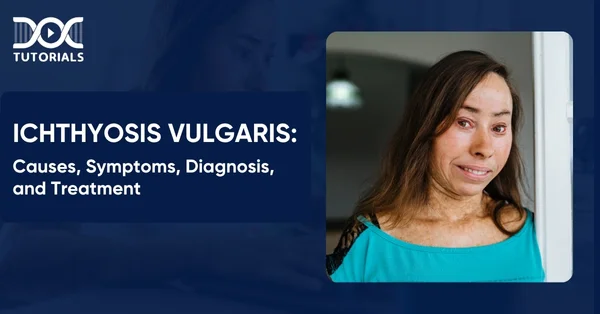Ichthyosis Vulgaris: Causes, Symptoms, Diagnosis, and Treatment

Ichthyosis vulgaris develops when an individual’s skin fails to exfoliate dead skin cells. It is an acquired or inherited skin condition that results in dry patches of dead skin cells on the skin surface. It is usually restricted to specific body parts, but it may also develop in the arms, back, abdomen, legs, or other parts of the body.
For medical students preparing for the NEET PG exam, understanding ichthyosis vulgaris thoroughly is crucial. Keep reading to learn more about its causes, symptoms, diagnosis, and treatment methods.
What is Ichthyosis Vulgaris?
Ichthyosis vulgaris, or fish skin disease, is a skin condition that causes the skin to resemble fish scales. It is a type of ichthyosis, a common skin condition that affects the ability of your skin’s dead skin cells to shed, leading to thick, dry skin.
Ichthyosis vulgaris is the most common type of ichthyosis, accounting for approximately 95% of all cases of this condition. The word “ichthyosis” refers to “fish scales”, and “vulgaris” refers to “common”. Children between the ages of 2 and 5 years are mostly affected by this condition.
What Causes and Increases the Risk of Ichthyosis Vulgaris?
The primary cause of ichthyosis vulgaris is genetic variation. It can occur during foetal development and can be inherited. Variation in genes can lead to defective filaggrin, a protein that forms a barrier in the skin by binding the cells together.
Thus, the separation of skin cells at the skin’s surface is affected, leading to the formation of scales on the skin. The following illnesses can also cause ichthyosis vulgaris:
- Kidney failure
- HIV (human immunodeficiency virus)
- Cancer
- Sarcoidosis
- Lupus
The following medications can also increase the risk of ichthyosis:
- Nicotinic acid
- Cimetidine
- Clofazimine
What are the Symptoms of Ichthyosis Vulgaris?
Here are some of the ichthyosis vulgaris symptoms that you must know about:
- Extremely Dry, Thick, and Scaly skin
The primary symptom of ichthyosis vulgaris is severe dryness, accompanied by the formation of thick, fish-like scales on the skin, a condition known as xerosis.
The scales may be white, grey, or brown, often polygonal in shape, and have curled edges that can make the skin feel rough. The skin usually flakes, and the scaling can be accompanied by visible peeling.
- Cracking of the Skin
In areas that are severely or persistently affected, especially the soles of the feet and palms of the hands, the skin may crack. These cracks can be deep and sometimes painful, increasing the risk of infection.
- Thickened Skin and Increased Skin Lines
The palms and soles may develop thickened skin with pronounced lines (hyperlinearity), and in severe cases, deep cracks can form.
- Itchiness and Discomfort
The dryness and scaling often cause itching and general discomfort, which can worsen in cold, dry weather.
- Irritation
The affected skin is more prone to irritation and further drying, making it susceptible to environmental triggers.
- Sweating Abnormalities
In rare cases, scaling can interfere with the function of sweat glands, causing either excessive sweating (hyperhidrosis) or an inability to sweat, which may lead to overheating.
The extensor regions of the limbs (especially elbows and shins), torso, scalp, and face (typically the forehead and cheeks) are most often affected by ichthyosis vulgaris. Symptoms usually develop around 2 months of age and are often mistaken for simple dry skin at first.
Approximately half of individuals with ichthyosis vulgaris also experience eczema (atopic dermatitis), which increases the risk of rhinitis, allergies, and asthma. Keratosis pilaris (rough, bumpy skin) and hyperlinearity of the palms and soles are also common associations.
The intensity of symptoms can range from mild to severe and often worsens during puberty or with factors that further dry the skin. These symptoms collectively impact both the appearance and comfort of the skin, often requiring lifelong management.
How to Diagnose Ichthyosis Vulgaris?
Diagnosing ichthyosis vulgaris involves several steps to ensure accurate identification and timely management. They are as follows:
- Physical Test
A healthcare provider will first perform a physical examination, closely inspecting the skin for characteristic dry, scaly patches and thickened areas. They will also review the medical and family history to identify any similar conditions among relatives.
- Biopsy
If the diagnosis is uncertain, a skin biopsy may be conducted. This involves removing a small sample of skin, which is then examined under a microscope to observe any specific structural changes typical of ichthyosis vulgaris.
- Genetic Testing
It is another diagnostic tool, especially useful when the condition’s inheritance pattern or specific gene mutations need clarification. This test can identify mutations associated with ichthyosis vulgaris, helping to inform further treatment and family planning decisions.
These combined approaches help distinguish ichthyosis vulgaris from other skin disorders, ensuring that patients receive appropriate care.
What are the Treatment Methods for Ichthyosis Vulgaris?
Ichthyosis vulgaris treatment involves managing the condition, as it cannot be cured. Here are some of the treatment methods to follow:
- Daily Moisturising
Apply creams, lotions, or ointments rich in ingredients such as urea, lanolin, alpha-hydroxy acids, propylene glycol, ceramides, or cholesterol to the skin daily. Moisturisers work best when applied immediately after bathing, while the skin is still damp, to help lock in moisture.
- Bathing Routines
Take frequent baths, sometimes more than once a day, to hydrate the skin and soften scales. Adding salt to bathwater can help reduce burning, stinging, and itching. For those prone to infections, a small amount of bleach may be added to the bath under medical supervision to lower the risk of infection.
- Exfoliation
Gently rub the skin with a pumice stone or rough sponge to remove dead skin. Topical products containing salicylic acid, glycolic acid, or lactic acid can also help exfoliate thickened areas and reduce scaling.
- Keratolytic Agents
Use creams with keratolytic ingredients, such as urea or alpha-hydroxy acids, to help break down and remove scales. These should be used regularly and as directed by a healthcare provider.
- Prescription Medications
For severe cases, doctors may prescribe oral retinoids such as acitretin or isotretinoin, which can reduce scaling but may cause side effects. Topical retinoids may also be considered.
Here are some more ichthyosis treatment methods one must know:
- Infection Management
If skin infections develop, topical or systemic antibiotics may be necessary. Preventative measures, such as bleach baths, may be recommended for individuals with a history of frequent infections.
- Lifestyle Adjustments
Use a humidifier to maintain moisture in the environment, wear loose-fitting cotton clothing, and avoid harsh soaps or detergents to minimise irritation.
- Mental Health Support
If ichthyosis vulgaris affects self-esteem or causes emotional distress, seeking support from a mental health professional is encouraged.
FAQs About Ichthyosis Vulgaris
- How to prevent ichthyosis vulgaris?
Most cases of ichthyosis vulgaris can’t be prevented, but regular soaking, exfoliating, and moisturising can help control symptoms and reduce the frequency of flare-ups.
- What increases the risk of ichthyosis vulgaris?
People with ichthyosis vulgaris often also experience hay fever, asthma, eczema, or food allergies. However, the exact connections between these conditions are still being researched by scientists.
- When should you visit a doctor if you have ichthyosis vulgaris?
Contact your healthcare provider if ichthyosis vulgaris becomes troublesome or if you notice signs of skin infection, such as fever, pus or fluid leakage, persistent pain or swelling, red streaks, or yellow crusts.
Conclusion
Ichthyosis vulgaris causes your skin to look like fish scales. Caused by genetic variation, this form of ichthyosis is incurable. Thus, knowing its symptoms will help manage the condition. Besides, if you are a medical student, covering this topic is essential as it comprises a vital part of the NEET PG syllabus.
In this regard, connect with DocTutorials. With us, you can prepare yourself for the NEET PG exam from the comfort of your home. Our comprehensive study materials, problem-solving classes, and routine assessments prepare every student with professionalism and care.
Check out our NEET PG course today and excel in your medical career!
Latest Blogs
-

INI CET Exam 2025: Your Roadmap to Success – Key Topics, Strategies, and Lessons from Last Year’s Papers
The INI CET exam is more than just a test; it’s a significant milestone for many medical students aiming to…
-

INI CET Exam Success: Previous Year Question Papers & Ultimate Guide – INI CET PYQ
One can feel overwhelmed while preparing for the INI CET (Institute of National Importance Combined Entrance Test). A vast syllabus,…
-

INI CET Exam Pattern 2024: A Complete Guide with Subject-Wise Weightage
The Institute of National Importance Combined Entrance Test (INI CET) is your key to entering some of the most prestigious…




